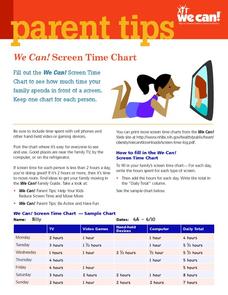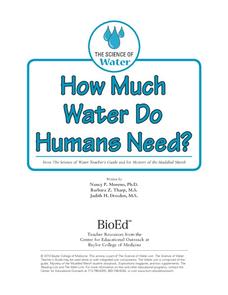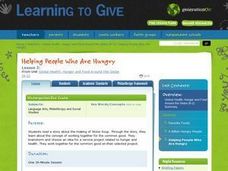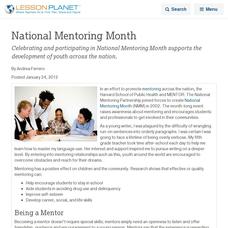Baylor College
Needs of Plants
What better way to learn about plant life than by creating a class garden? Young botanists start with a brief discussion about radishes before planting seeds and watching them grow. To determine the importance of water,...
We Can!
We Can! Screen Time Chart
Screens are everywhere these days, from televisions and video games to cell phones and computers. Raise awareness of excessive screen time by helping your learners track how much time they each accumulate on a daily basis looking at...
Texas Center for Learning Disabilities
Teacher Templates
Letter by letter, sound by sound, monitor the growth of your emergent readers with these assessment templates. Adaptable to the needs of individual students, these one-on-one assessments focus on children's ability to identify...
Baylor College
How Much Water Do Humans Need?
Physical or life science learners measure the amounts of water eliminated by intestines and the urinary system, and the amounts lost via respiration and perspiration. In doing so, they discover that the body's water must be replenished...
Baylor College
Do Plants Need Light?
Turn your classroom into a greenhouse with a lesson on plant growth. First, investigate the different parts of seeds, identifying the seed coat, cotyledon, and embryo. Then plant the seeds and watch them grow! Measure the new plants...
Baylor College
What's Is Soil Made Of?
It's time to roll up those sleeves and get a little dirty in the second lesson of this series on the science of food. Investigate where plants and animals get the minerals they need to live in this two-part exploration of soil. First,...
Curated OER
Good and Bad Touches
Students evaluate whether certain physical actions constitute a "good touch" or a "bad touch". In this sensitive health lesson, students are read a book about types of touches, and then compare and contrast between good and bad types....
Baylor College
Digestion
Digestion is an amazing and complicated process that provides humans with the energy they need to survive. Lesson six in this series on the science of food uses sliced turkey and a meat tenderizer to demonstrate how enzymes help break...
Curated OER
Dangerous Situations
Students identify trusted adults and learn how to respond to dangerous situations
Curated OER
Relationships, Day 1: Self-Esteem
Students explore self-esteem and create a self-portrait collage. They discuss things they like about themselves, things they are able to do on their own, and reasons people appreciate them. They demonstrate how to give and receive...
US Environmental Protection Agency
Aquifer in a Cup
Young scientists create their very own aquifers in this science lesson on ground water. After learning about how some people get their drinking water from underground wells, young learners use sand, modeling clay, and aquarium rocks to...
Baylor College
Healthy Snacks
Assess your pupils' ability to identify healthy food choices in the final lesson of this series on food science. Given five different food labels, young nutritionists will rank them from most to least healthy, supporting their choices...
Curated OER
Can You Name Parts of the Body?
Students share what they know about the human heart. In this early anatomy lesson, students discuss the location, shape, and importance of the human heart.
Curated OER
Helping People Who Are Hungry
Students discuss the concept of hunger. In this hunger lesson, students discuss the book, The Story of Stone Soup. Student then brainstorm a possible service project ideas and create plans to carry out their service project.
Curated OER
The Dentist
Students read a short story about visiting a dentist. Then they use toothbrushes in order to demonstrate the correct way to brush teeth. Students use the internet to investigate how some foods are healthier for teeth than others. Then...
Curated OER
Responsibilities
Students identify different responsibilities they have at home and at school. In this responsibilities lesson plan, students identify the responsibilities they need to follow through on and what happens when they don't. They put...
Curated OER
People Who Work
Students chart volunteers they are familiar with in school, church or in the community. In this nonprofit jobs, lesson students understand that all members of a community need to take responsibility in that community. Students vote on...
Curated OER
Safe ways to take medicine
Students match who to contact if they need help in certain situations and discuss safety with medicines. In this medicine lesson plan, students match the person who can help them take medicine safely. They also participate in a...
Curated OER
National Mentoring Month
Celebrating and participating in National Mentoring Month supports the development of youth across the nation.
Curated OER
Tattling and Telling
Students identify ways to prevent bullying. In this character education lesson, students discuss the difference between tattling and telling and perform a puppet show to illustrate these differences.
Curated OER
Brushing Your Teeth
Students use a shoe box to simulate what happens when candy gets between your teeth. In this teeth brushing lesson plan, students explore the importance of brushing your teeth. Students listen to Brush Your Teeth Please. Students...
Curated OER
Feelings and Emotions
Students discuss and write about different feelings they or someone else may have. In this feelings lesson plan, students discuss different ways they express their feelings. Then they get a picture with someone who is demonstrating a...
Early Childhood Learning and Knowlege Center
My Body My Senses
In a comprehensive unit of activities, learners explore the five senses. Youngsters discover the many different body parts and their functions that allow humans to have sense of sight, touch, smell, taste, and hearing. The best way to...
Curated OER
Feelings
Students describe how they feel in different situations. In this feelings lesson plan, students respond to questions asked by the teacher while reading the book The Way I Feel. They also use mirrors to show look at their own faces while...























